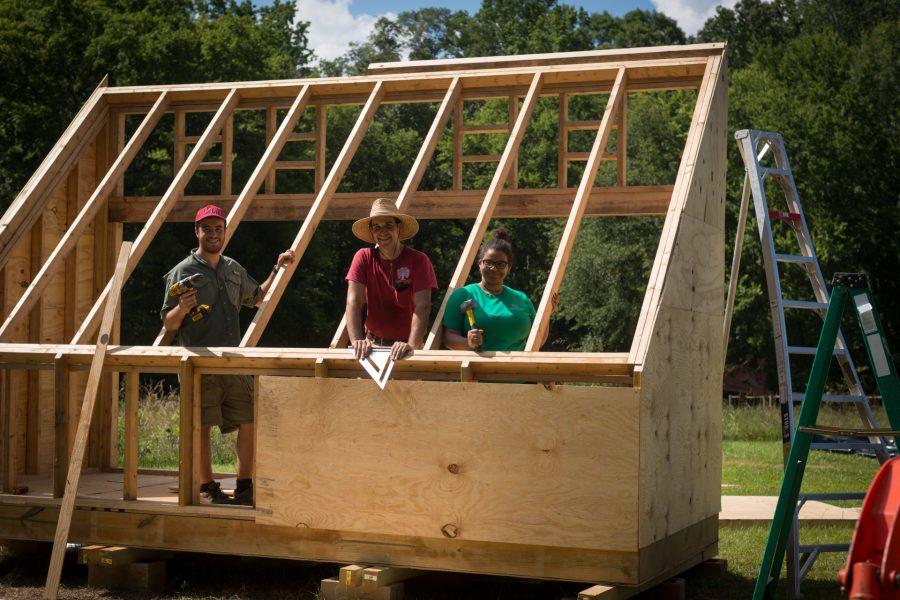William MacGavin has been woodworking since he was 11 years old. Over the years he’s salvaged wood from Christmas trees left on the curb, trees downed in storms or trees cut down by a city to make didgeridoos and other projects. So when he saw a construction crew taking down some oaks, pines and magnolias near North Lawn Hall while it was being constructed, he asked where they were taking the wood.
“They said ‘Oh we’re just hauling this off somewhere. It’s either going to be mulched or just probably taken to the dump to rot’ and that really bothered me,” MacGavin said. “I’m a woodworker, so I was like ‘That is some quality logs right there and it be great if the University could recycle those.’”
MacGavin, who recently graduated from UA with a degree in architectural engineering, was also president of the Green Building Council. He and other members began brainstorming ideas about how to save the wood from trees that are taken down or fall down on campus.
One part of their solution was a solar powered drying kiln, currently being built at the University’s arboretum. Inside the kiln, the wood is stacked and spaced to allow for airflow and as the sun’s heat is absorbed into the kiln solar powered fans circulate air to keep humidity down and allow the moisture to be pulled from the wood.
“It’s very efficient,” he said. “If we left those boards sitting outside they’d take years to dry where in this, it’ll take a few months.”
The first wood to be going in is pine lumber that the arboretum will then use to make benches. But soon the kiln will be used to dry wood from a water oak that was removed from the lawn of the President’s Mansion on May 22.
The tree was in danger of falling according to David Patterson, the president of the Woodworkers Association of West Alabama. Patterson said he’d been in contact with the University before about the protocol for downed trees on campus, so when the tree needed to be removed, he was contacted.
“They’ve communicated with us on a series of several trees that have come down recently,” Patterson said. “So we’ve harvested some of what we could. In the future, I’m going to be trying to put together a set program that will take us through anytime say there’s a storm and a tree comes down hopefully they would be able to quickly look at a list, maybe in an app and it with that’s a valuable tree that we would like to harvest.”
MacGavin, who is also a member of the association, said that members were there for a few hours on May 22 working with University arborists to determine which parts of the tree could be salvaged and sent to the mill. By his estimation, he said, over half the trunk was saved along with some longer limbs to be dried in the kiln and later used by local woodworkers.
“There’s a want, there’s a drive for this to happen and it’s great to see that the University staff are so helpful in making this happen,” MacGavin said. “It wasn’t I guess something they immediately thought of but the local community, some of the students, the arboretum and the Green Building Council, all are interested in saving University wood.”
The wood from the President’s Mansion oak is currently being milled into lumber and the plan is to put it into the solar kiln in mid-July, though Patterson said some members of WAWA already have some of it.
“Some of the people that turn bowls have some of it now and I’ve asked that if somebody took enough to make a couple bowls with maybe they could keep one and I’d like to be able to have one to give back, to put in the President’s Mansion,” he said.
Arboretum caretaker Joseph Wright said he hopes this collaboration will continue for the next 20 or 30 years.
“The trees, some of them have been growing for hundreds of years so it’s a shame to lose those trees that we have on our campus,” Wright said. “On our grounds, it’s even more of a shame to have them gone forever. This is a way to kind of immortalize them at least for our lifetime and be able to use them and continue to see the beauty in those trees.”
For MacGavin, who hopes to get his hands on some of the wood to make into a didgeridoo, reurposing the trees is about something else.
“It’s about respect for the trees and giving them a longer life than they’re already long lives are,” he said.









